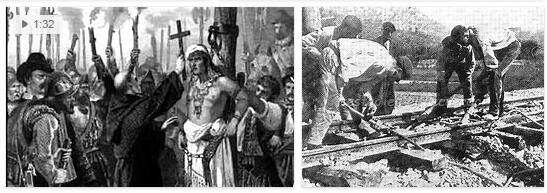TERRITORY: ENVIRONMENT
The climatic characteristics determine relevant varieties of vegetal landscapes. The lush forest rainforest, rich in essences from cabinet making, medicinal plants, rubber trees, etc., Covering the whole of the ‘ East; dense forest mantles are also present in the wetter northern regions of the coast and on the Andean slopes up to 2000 m, above which xerophilous species appear, including cacti, followed at around 3000 m by the herbaceous and shrubby steppe expanses of the páramos. The savannah finally it prevails in the arid southern coastal strip, while the coast is largely fringed by mangroves. 39.2% of the territory is still covered by forests but the practices of exploitation of timber and land threaten this heritage, particularly in the Sierra and the Coast, while the covering of the East is almost intact.. Ecuadorian environmental legislation is precise and diversified: there are national regulations relating to the management of the environment and the safeguarding of natural heritage, forestry laws and the conservation of natural areas (a special law exists for the province of Galápagos, 1998) and regulations on pollution prevention and control. The forest law establishes that the Ministry of the environment is responsible for the national system of protected areas, which covers 15.1% of the national territory, and which includes 11 national parks (the oldest of which, that of the Galápagos, dates back to the Fifty of the twentieth century), numerous reserves and over a hundred protected forests. Safeguarding the country’s ecosystems appears to be a matter of considerable importance if we consider that in such a limited territory there are a truly exceptional amount of animal and plant species. Two of Ecuador’s national parks have been declared a World Natural Heritage Site by UNESCO: the Sangay National Park (1983) and the Galápagos Islands National Park (1978, 2001). The first, located between the Cordillera Oriental and the Amazon basin, is characterized by the extreme diversity of ecosystems ranging from the rainforest to the high Andean peaks dotted with glaciers. The second, which includes the archipelago of Colón, is considered a living museum, the home of endemic species (40% of the species present on the islands are), especially reptiles (turtle and iguana) and birds; this is the place that allowed Charles Darwin to progress in the formulation of the theory of evolution. In January 2001, the accident involving the oil tanker “Jessica” not far from San Cristobal Island caused the spill of crude oil; the environmental disaster was only partially contained thanks to the favorable currents and the timely rescue of US Coast Guard vehicles. The site was registered in 2007 in the list of UNESCO sites in danger.
HISTORY: FROM THE SPANISH CONQUEST TO THE FIRST CONSTITUTION
According to areacodesexplorer, the Ecuadorian coasts were touched by the Europeans even before the Peruvian ones. In fact, in 1528, Francisco Pizarro and Diego de Almagro, to prepare for the conquest of Peru, explored the areas of Túmbes and Atacames. However, it fell to Sebastiàn de Belalcázar to occupy Ecuador after the assassination of the Inca Atahualpa. Next to the old San Francisco de Quito in ruins rose the new Quito (today’s capital). The first governor of the colony was from 1540 Gonzalo Pizarro, half-brother of Francisco, who also went into the Amazonian forests. Real Audiencia headquarters from 1563, Ecuador was part of the Viceroyalty of Peru until 1717, when it was incorporated into the newly established Viceroyalty of New Granada. Its political-administrative organization was similar to that of the other Spanish colonies in South America. The socio-economic structure also repeated the models; therefore, gradually, a landowner oligarchy of Spanish origin was established, above the great indigenous mass, forced to agricultural work and the humblest domestic or artisanal services; at the center, between these two categories, the merchant and bureaucratic class, of European extraction but native to the place (criollo). Precisely among the criollos at the end of the century. Eighteenth-century autonomy tendencies began to spread, which soon translated into aspirations for independence. The most influential proponent of such ideas was Francisco Eugenio Espejo de Santa Cruz, secretary of the Patriotic Society of Friends of the Country, who died in prison in 1796. On August 10, 1809 insurgents Creoles deposed the Iberian authorities and settled a revolutionary junta. The liberation, however, came only in 1822, after the military victories achieved in Yaguachi and Pichincha by General Antonio José de Sucre (1821 and 1822). Ecuador was thus able to join – as a third member together with Colombia and Venezuela – the Republic of Gran Colombia, established by Simón Bolívar in December 1819. But in 1830 the union crumbled and each of its members became a sovereign state. Ecuador gave itself its first national constitution on 23 September 1830 and elected General Juan José Flores as president of the Republic, exponent of the Creole aristocracy and representative of the interests of the oligarchs of the hinterland: therefore it was opposed by liberals, especially strong in the coastal area and merchant of Guayaquil. A compromise between the two sides led the liberal Vicente Rocafuerte to lead the state in 1835, who reformed the constitutional charter; Flores resumed office four years later (he too revised the Constitution, accentuating its authoritarian aspects). The struggle between liberals and conservatives flared up again, now leading each other to power.
